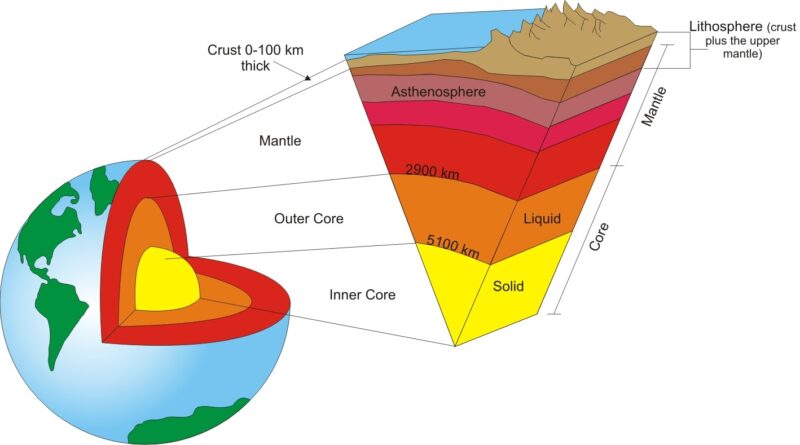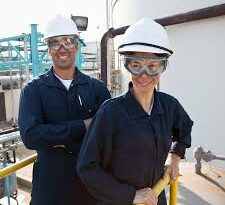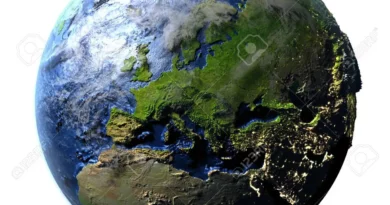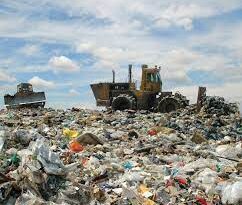Lithosphere (earth’s crust): Man and The Lithosphere
This article helps you to know the structure and the mineral composition of the lithosphere, as well as the utilitarian value of the lithosphere to man.
The lithosphere otherwise known as the earth’s crust is made up of two parts. The upper part is made up of granitic rocks and forms the continent. This part is rich in minerals such as silica and alumina and is collectively called “SIAL”.
While the lower part, made up of basaltic rocks forms the oceanic crust. This part is rich in silicon and magnesium, and the two collectively form what is known as “SIMA”.
The SIAL has an average density of 2.7g/cm3 while ‘SIMA’ has a density of 3.0g/cm3.
The SIAL continents, of a lighter material than the “SIMA”, tend to float upon it like icebergs in the sea. Beneath the outer skin (that is the lithosphere), are the mantle and the core. Generally speaking, the lithosphere is often erroneously regarded as a passive factor in the environment. The fact it provides a solid table platform for life supports this belief. But the lithosphere is not passive.
It is just the process going on in the lithosphere operates at a very slow rate when compared with the process operating or going on in the atmosphere, biosphere, and hydrosphere.
Unlike the biosphere and hydrosphere, the energy of the lithosphere is largely independent of the solar energy system which dominates the atmosphere and hydrosphere. The most important source of energy in the lithosphere is radioactivity. This is the energy generated through the decay of certain mineral elements known as radioisotopes.
Read Also: How Waste Papers, Metals, Woods, Glasses, and Plastics are Recycled
Generally, the radioisotopes are concentrated in the outer layer of the lithosphere. The heat generated by these radioisotopes is responsible for the molten nature of the inner core. Of all the energy systems, the energy system of the solid earth (earth crust), is the least subject to alteration which is about 16 -44 km thick.

This is the portion of the lithosphere that is in contact with the atmosphere, hydrosphere, and biosphere. This outer layer contains all the relief features on earth; it also contains the continent and ocean, soil, gases, and water.
The most abundant mineral in the earth’s crust is silicate minerals. Silicate compounds are compounds that contain a combination of silica and oxygen to one or more metallic elements.
These silicate minerals fall into two (2) groups: i. The Felsic group and ii. The Mafic silicate group.
The felsic consists of quartz and felspars. A good example is Sj02.
Man interacts with the lithosphere in several ways, and the result of the interaction may be positive or negative. As far as man is concerned, the lithosphere provides the resources as well as the resistance and environmental hazards.
On the other hand, man modifies the lithosphere in many ways. Unfortunately, most of the impacts of man on the lithosphere are destructive.
As far as the resources provided by the lithosphere are concerned, they are either in the form of minerals or in the form of landforms or processes that man can take advantage of. For example, the lithosphere provides man with minerals, soil as well as water stored in water-bearing rocks.
The minerals provided by the lithosphere can be divided into three (3) types:
1. Metalliferous minerals e.g. Iron, Copper, and Bauxite.
2. Precious minerals like gold, silver, and diamond.
3. Non-metallic minerals especially the structural materials, building sands, stone, gravel, etc.
Apart from these, there are also salts like sulphur salts, chlorides, phosphate, and even fossil fuels such as coal, liquid, petroleum, and gas. In some parts of the world, we have nuclear fuels such as Thorium and Uranium.
Read Also: The Need for Effective Waste Management Policies
In addition, the lithosphere also provides non-renewable resources. These are resources whose rate of exploitation is several times greater than the rate of replenishment. Most of these non-renewable minerals continue to increase every day.
Perhaps, the most important resource provided by the lithosphere is the soil. Soil is formed from weathered materials, organic matter, air, and water.
It is the medium of plant growth, and is therefore very crucial to man’s food supply. The physical, chemical and biological characteristics of soil determine the four important qualities of land.
1. It determines the ability of the land to provide nourishment to plants and animals.
2. It also determines the ability of the land to provide water for plants, lakes, and streams.
3. Also the ability of the land to give mechanical support to plants, animals, and buildings.
4. These characteristics provide materials for construction purposes.
As far as the landforms are concerned, the landforms provided by the lithosphere have aesthetic value, and very good educational resources e.g. Volcanoes, mountains, warm springs, inselberg, rivers, waterfalls, etc.
Despite all these resources provided by the lithosphere, it also provides resistance. For example, mountains, gullies, waterfalls, and gorges are most of the time obstacles to the movement of communication lines.
Read Also: How to Make Money using Sa Recycling Company
Similarly, earthquakes, mudflows, landslides, and floods are environmental hazards where they occur. Finally, as far as man’s impact is concerned, we discover that most of their impacts are largely negative.
1. Man extracts minerals from the lithosphere and this may result in serious environmental consequences. For example, it could lead to what is known as despoliation of the land surface. Scars are created on the landscape when minerals are exploited.
2. Extraction of minerals may also lead to subsidence, which may eventually lead to mudflow.
3. Extraction could also lead to water stream channels.
When minerals are exploited by sophisticated means, it can lead to air pollution. In some cases, when the extraction is very near the sea, like the extraction of fossil fuel, it could lead to ocean pollution.
Finally, man is an agent of erosion when he carries out deforestation for cultivation or building purposes. These are the complex interrelationship between man and the lithosphere.



